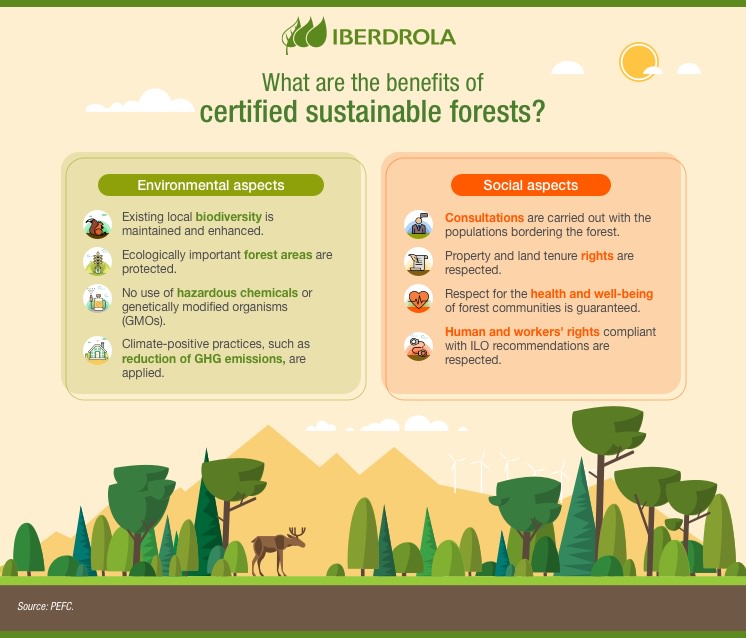Sustainable forest management
Sustainable forest management: the key to preserving the future of forests
Sustainable management of resources is essential to minimising the impact of climate change, and this must also apply to forests, whose health is of concern in view of the advance of deforestation. Specifically, the FAO states that forests should be harvested at a rate that maintains their biodiversity, productivity and regeneration capacity.

Who doesn't like to use the weekend to get away from the city and spend a few hours in the forest? Breathing the clean air provided by the trees helps to recharge your batteries for a week of hard work. For this and many other reasons, forests, are essential for humans and the rest of the planet. However, we can state that the relationship is not reciprocal, as we do not give the same good back to them, rather the opposite.
According to the FAO, forests cover approximately 31 % of the world's land area, of which only half is relatively intact. Forest degradation, largely due to deforestation, is proceeding at an alarming rate, with a significant impact on biodiversity loss. The world is currently a long way from meeting the target of the UN Strategic Plan for Forests, which calls for a 3 % increase in forest area by 2030. One way to correct this trajectory is through sustainable forest management.
Sustainable forests
Sustainable forests are those whose management allows the provision of resources while preserving their other uses and services. Sustainability ensures their regeneration and is key to maintaining the economic activity linked to their exploitation. Thanks to this form of management, the multitude of benefits that forests provide to the planet will be assured in the future. Below, we review some of them:
- They encourage the conservation of biodiversity, by acting as a home to numerous species.
- They provide a multitude of essential resources for the daily activities of human beings.
- They help to combat climate change by acting as carbon sinks and regulating the climate.
- They facilitate soil formation and prevent the soil erosion caused by phenomena such as desertification.
What is sustainable forest management
Forest management, according to the FAO, is a process of planning and implementing practices for the management and use of forests and other wooded land to meet specific environmental, economic, social and cultural objectives. In short, it can be seen as the sustainable use and conservation of forests in order to maintain and enhance their multiple values and meet the diverse needs of society in perpetuity through human intervention. It is noted that it is a “dynamic and evolving” concept, i.e. it will change over time.
Areas of sustainable forest management
Sustainable forest management (SFM) is a multi-dimensional and multi-purpose concept with seven thematic elements or management areas:
Extent of forest resources
Refers to the need to maintain adequate forest resources to promote the social, economic and environmental objectives of forests and forestry in a country or region.
Forest biological diversity
Refers to the preservation of the diverse forms of life in forests, the ecological functions they perform and the genetic diversity they contain.
Forest health and vitality
They are subject to climate-influenced disturbances. In particular, climate change will affect their frequency, intensity or duration and increase the susceptibility of the forest to them.
Productive functions of forest resources
They provide a wide range of timber and non-timber forest resources, so their productive function is an element to be taken into account when making forest assessments.
Protective functions of forest resources
They provide protection and environmental services, which must be taken into account for sustainable forest management.
Socio-economic functions of forest resources
They provide a wide range of social and economic benefits. These can range from easily quantifiable economic values to values of an intangible nature for society.
Legal, policy and institutional framework
Sustainable forest management depends on a national framework created on the basis of international consensus, which is used by many countries for policy development and implementation.
Forest certification
Forest certification is a process by which the management of a forest area is accredited as meeting a set of requirements related to sustainability. In other words, it is basically an instrument that guarantees consumers - and companies - that a product has been made from forest raw materials that come from a sustainably and responsibly managed forest.

SEE INFOGRAPHIC: What are the benefits of certified sustainable forests? [PDF]
PEFC certification
The Pan European Forest Certification (PEFC) promotes objectives related to environmental conservation, productivity improvement and the promotion of socio-economic development in rural areas. It is a non-profit organisation that was born out of an initiative from the private forestry sector.
FSC certification
The main objective of the Forest Stewardship Council (FSC) is to promote environmentally responsible, socially beneficial and economically viable forest management. Independent and non-profit, this organisation is endorsed by prestigious NGOs dedicated to protecting the environment.




